Dhansak is a famous Parsi dish. Indian restaurant dhansak curry is adapted from the traditional. But the big flavours, lentils and a bit of sweet and sour remain.
Dhansak gets it roots from Persian cuisine
Little bit of history. The Parsis were from Persia and migrated to India to escape persecution in or around the 10th century. That’s the beauty of history.
People move around. They bring their cooking with them. Don’t mean to oversimplify but immigration is good for food. Diversity. Variety. Ideas.
My guess is this dish started out as a way to stretch a relatively rare and expensive ingredient – meat – with plentiful and cheap lentils.
It’s a wonderful dish done the original way. Try that some time. It’s also really good done the Indian restaurant dhansak curry way. Try that too.
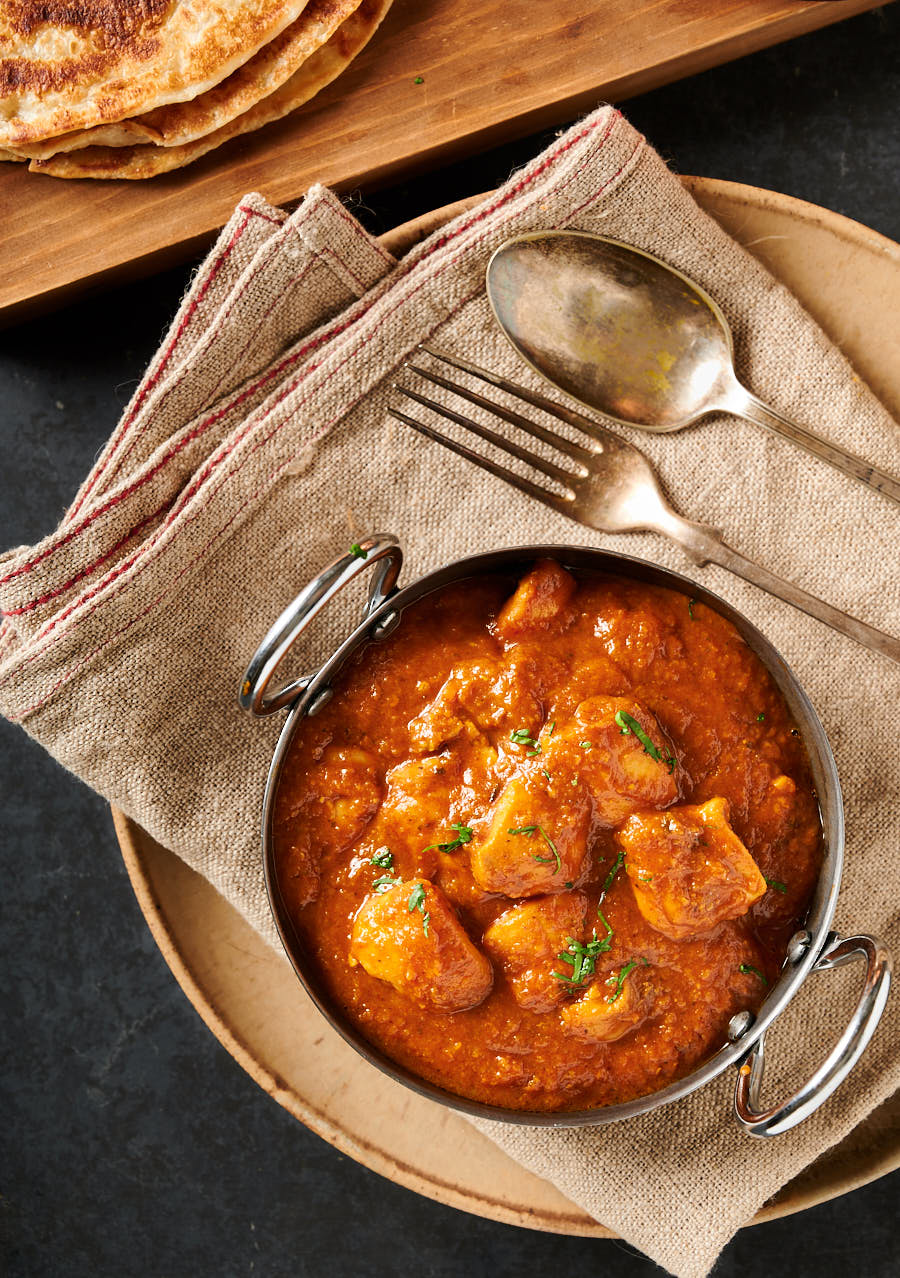
The lentils give the sauce it’s body
The lentils are cooked until they disintegrate. They disappear into the sauce but they bring body and smoothness.
The sweet and sour notes come from tamarind sauce. If you don’t want to get tamarind sauce use a bit of sugar and fresh lemon juice. Don’t worry – it will still qualify as Indian restaurant dhansak curry.
Tamarind sauce is not the same as tamarind paste
This recipe calls for tamarind sauce. Specifically I use Maggi Tamarina. I don’t like to call out product names if I can avoid it. But this is pretty important.
There are different tamarind products out there. You can get a block of tamarind and make it yourself. That’s hard.
You can buy tamarind concentrate or tamarind paste. That’s pretty much pure tamarind and has a far stronger tamarind flavour.
If you want to substitute tamarind paste use 1 tsp or 2 tsp sugar. That should give you about the same flavour profile. Not exactly the same. But close.
Make it with chicken, lamb or beef – or serve it as a lentil curry
This curry works well with chicken, lamb or beef. It’s great as a vegan lentil dish. Increase the lentils to about a cup and just don’t add any meat.
That’s actually better depending on your mood. Could be the best lentil dish ever. Creamy lentils with in your face dhansak flavours.
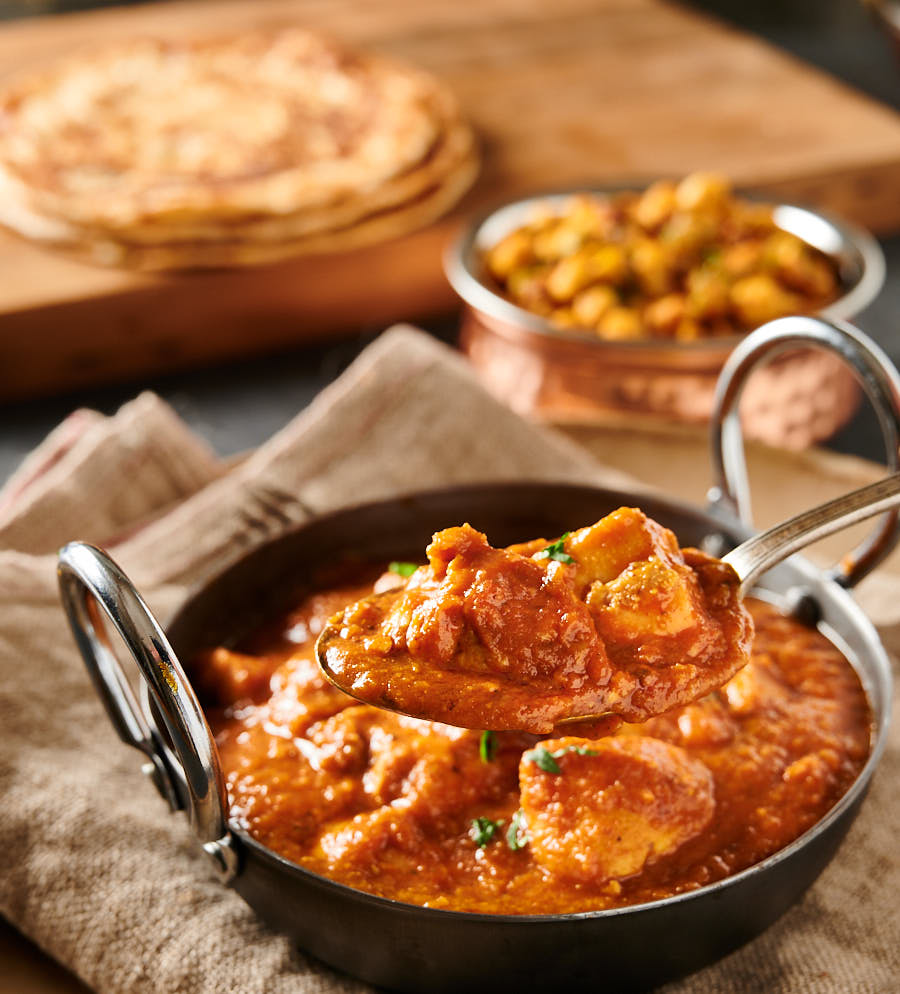
Always do your prep for Indian restaurant style cooking
Do your prep before you get started. Make your curry base and have some heated and ready to go. Pre-cook your meat.
Measure out your ingredients. Have everything ready. Restaurant style Indian curries take about 10 minutes to cook. There is no time to fiddle once you get started.
Oh, and put on some old clothes. A bit of splatter is part of the fun but turmeric stains are murder to get out. Don’t say I didn’t warn you.
If you read the guide to Indian restaurant technique yet, do it now. It has pictures to help you understand the recipe. There’s also a guide to Indian ingredients in that post.
Indian restaurant dhansak curry is a great dish. Creamy from the lentils with a great balance of savoury and sweet. If you are a fan of Indian food this one hits the spot. Just really, really tasty.
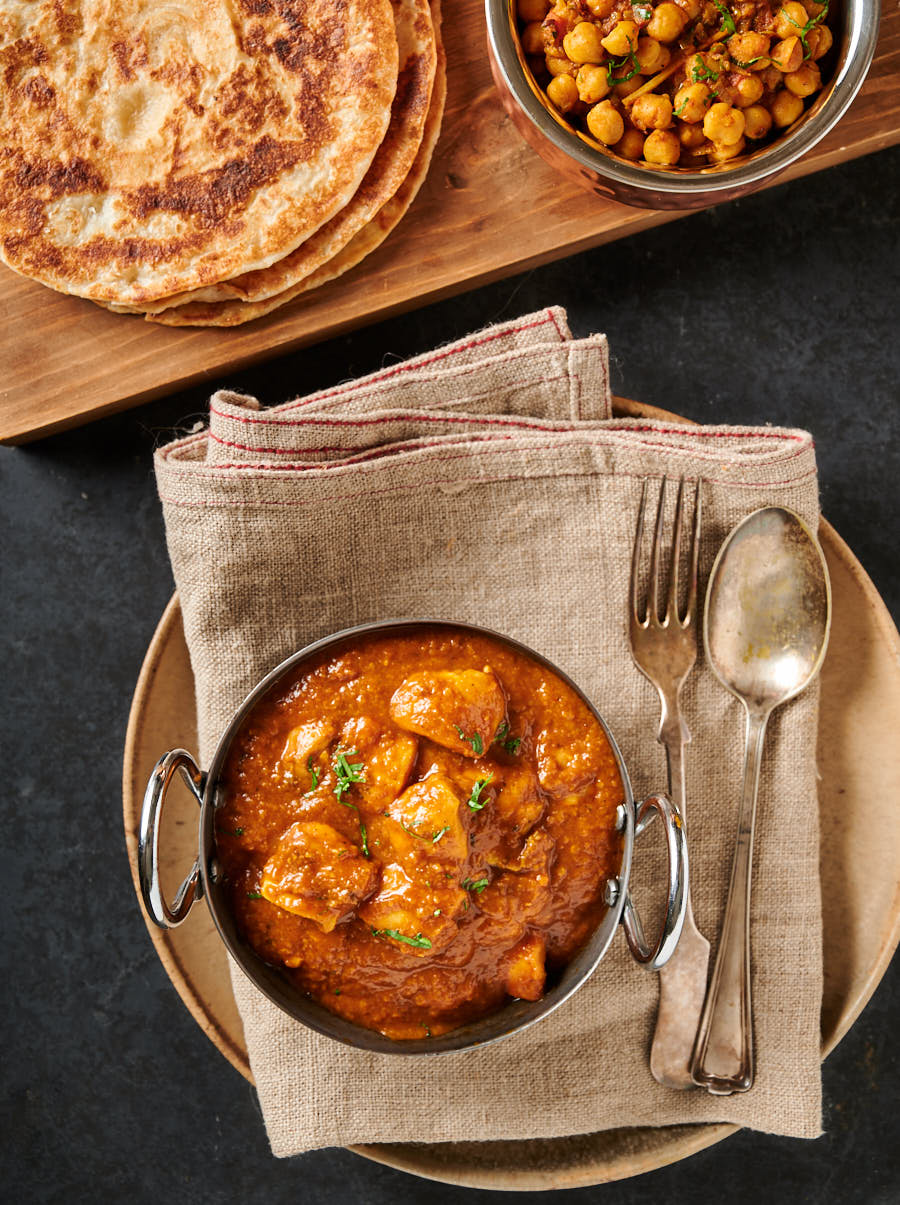
indian restaurant dhansak curry
Ingredients
The spice mix
- 2 tsp indian restaurant spice mix or curry powder – recipe link below
- 1 tsp kashmiri chili powder or 1/4 tsp cayenne mixed with 3/4 tsp paprika
- 1 tsp kasoor methi – dried fenugreek leaves
- 1/2 tsp kosher salt
The curry ingredients
- 3 Tbsp oil
- 1 Tbsp garlic/ginger paste – recipe link below
- 1 Tbsp tomato paste with enough water to dilute to the consistency of pasatta
- 15 oz curry base
- 1-2 Tbsp tamarind sauce (not the same as tamarind paste) – more will crank up the tart/sweet nature of this curry. If you want to substitute tamarind paste see the note below.
- 5-6 Tbsp cooked masoor dahl – make a tarka dahl and use a bit of the lentils in the dhansak
- 10-12 oz pre-cooked chicken or lamb
Instructions
- Make the spice mix.
- Dilute the tomato paste with enough water to get to the consistency of passata.
- Heat your frying pan (don’t use non-stick) briefly over medium heat. Add the oil. Use all the oil specified. It’s important.
- When the oil starts to shimmer add the garlic ginger paste. Add it into the pan and cook it, stirring constantly, until it stops sputtering.
- Turn down the heat and add the spice mix. This is the critical step. Stir it constantly for 30 seconds. If it starts to darken lift the pan off the heat. You want the spice mix to cook in the oil but not burn.
- Turn the heat up to medium high. Add the diluted tomato paste and stir until bubbles form (the oil will likely separate). This takes around 30 seconds to one minute depending on the heat.
- Add 3 oz of curry base. Stir until bubbles form (little craters really), around 30 seconds. Watch the edges of the pan. The curry can stick here.
- Now add 6 oz of curry base and stir briefly. Let it cook until the bubbles form again. This takes 1-2 minutes.
- Add the rest of the curry base and let cook until the bubbles form. Turn the heat down to low. Add the tamarind sauce to taste.
- Stir in the lentils.
- Now add the pre-cooked lamb, beef or chicken. For a vegetarian version add the paneer and/or pre-cooked vegetables.
- Let the curry simmer for about 5 minutes. If it gets too thick add a bit more curry base. Don’t add water.
- Garnish with a bit of chopped fresh cilantro and serve.
Notes
Nutrition
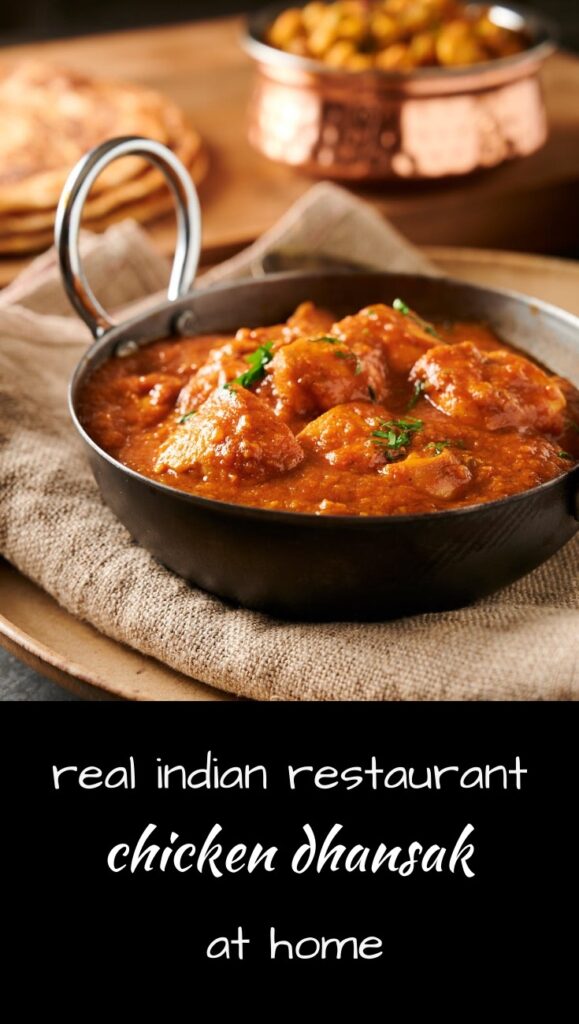

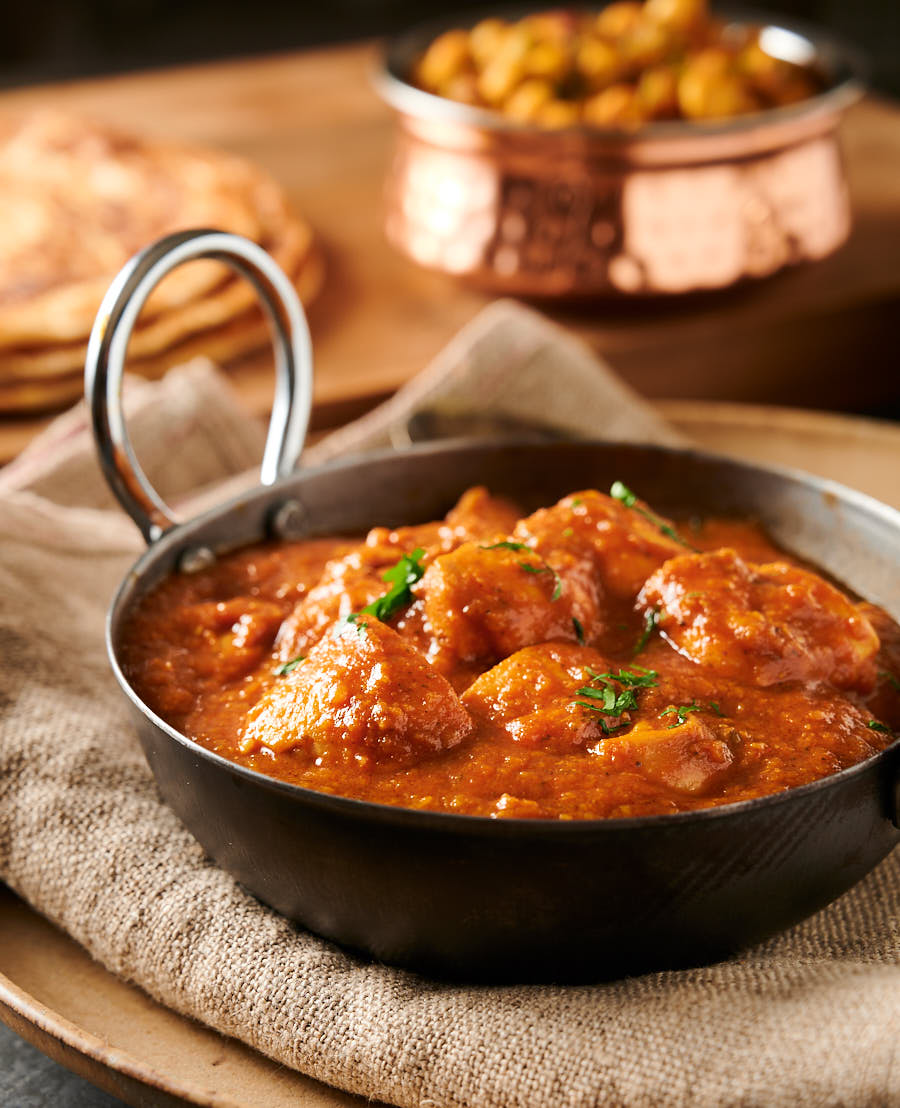
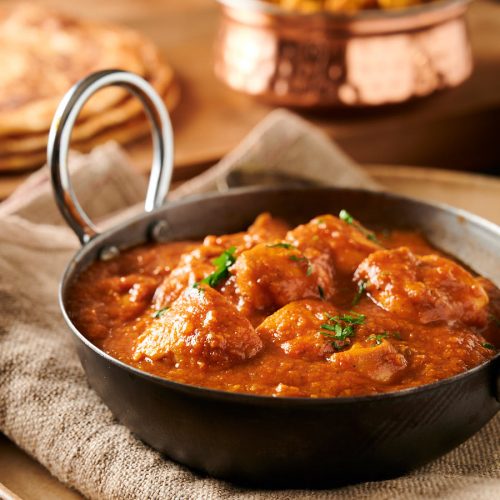
I’m going to cook this but I don’t have time to also cook a tarka dhal as well as the base sauce, garlic/ginger etc. Can I just add in red split lentils to the sauce instead?
I don’t often say anything definitively unless I’ve tried it but in this case I’m going to say no. You can just cook some masoor dal with a little turmeric the day before and have it ready to go. And make the tarka another day.
I’ve recently cooked myself a big batch of curry base and mixed myself a jar of spice mix so that I can start trying the restaurant style curries on this website! Really impressed with the jalfrezi that I made last night. Tonight I made this dhansak dish and I felt I needed to boost the flavour a bit (perhaps I added too much unseasoned lentils!). I added an extra 1/2 tsp salt, doubled the tamarind sauce and added 2 tsps of hot chilli powder. The end dish was hot, sweet and sour, just like a restaurant dhansak. Thanks for the great method and recipe, I think I might cook the Madras next!
Delighted to hear you are enjoying cooking restaurant style. I’m pretty heavy handed with salt so I am guessing you are right and that you added extra lentils. That, or you are a bigger flavour junkie than even I am!
Hi, I have recently been joining an online Indian cookery class, organised by one of the doctors from the hospital my partner works at. She gives up her time, free of charge, to help beat the lockdown boredom.
One of the first things we cooked was Tarka Dhal. Very tasty and I assumed a part recipe for my favourite Indian dish of Dhansak.
The best Dhansak I’ve ever had (and the only one of its kind I’ve found) had a very thick, garlicky, peppery sauce. No whole lentils remained, but it was the consistency of a mashed potato. No matter what I do, I can’t get my lentils to end up like it! Any ideas/tips please??
There’s a recipe on glebekitchen for a tarka dal with a video that you could take a look at (also on the glebekitchen YouTube channel).
You didn’t mention what kind of lentils you are using. I find, for tarka dal, that masoor or toor dal are the ones that really break down to give you that creamy consistency. It can take up to an hour with masoor dal (less with toor dal) but I’ve never had it not get there myself.
Friday night is curry night in my house and I made this dhansak Friday just gone, it was one of the best curries I’ve ever had. For the pre-cooked meat I marinaded some chunks of lamb neck in a mint and mixed spiced paste for a few hours (marinade recipe tweaked from Romain’s tandoori chicken, no yoghurt or lemon juice) then cooked the pieces low and slow in the oven for a couple of hours.(120C covered in foil, the meat was superb)
Everything else was exactly as per the recipe including the base gravy, which by the way is a far simpler base than many of the other base curry recipes around.
I served the dhansak with mushroom pilau rice, Saag Aloo (my own recipes) an aubergine mint pickle (Madhur Jaffrey recipe) and a couple of parathas from Tesco (UK supermarket) that are actually really good, you can find them in the frozen section of a big Tesco, surprisingly high standard. I’d always make my own naan, chapatti, bhatura or poori but parathas are hard work so I often use these frozen ones.
I use a lot of different recipes when cooking my curries, I’ve got a bunch of books covering traditional and restaurant style but the Glebe Kitchen website is the one that consistently delivers, every time, and as I say this dhansak really stood out.
If you’ve not checked out the hotel style curries on this site I recommend you do, it’s a really original approach and I made half a dozen of those curries every Friday night for a while a few months back.
Keep doing your thing Romain, it’s really appreciated. 👍
That sounds like an absolute feast! Thank you for the kind words. I’m delighted you are enjoying the dishes here and hope you keep finding things you like.
I use the frozen parathas myself. That or the ones they sell fresh made at my local Indian grocer. They really are a lot of work…
My wife’s favourite Indian and I’m persuaded to make this on a regular basis. Tastes great using the Tarka Dahl recipe elsewhere on here – I make up a batch and freeze into appropriate 6 Tbsp portions.
Great idea. Little lentil portions just ready to go into dhansak on demand. I’m going to start doing that.
I’ve made 3 dishes from the glebe recipes and they’ve all come out really lovely. Dhansak my favourite much better than some restaurants and take aways I’ve had. In fact I wouldn’t buy another take away my wife’s favourite is the karahi and another favourite of mine. I’ve made a dhansak for my son and daughter and both said stunning flavours. I highly recommend glebe kitchen recipes
That is awesome. I don’t buy takeaway any more either. Glad you are enjoying it!
This is an excellent recipe and the third dish from the restaurant series here that I have cooked. It takes a little preparation time – make sure you have the basics ready – like ginger garlic puree, the liquidised onion spice base, pre-cooked lentils, pre-cooked meat. If you cook Indian often, prepare them all in bulk and freeze them, it makes the cooking a breeze.
I put everything into little dishes before I start cooking as the restaurant style is very fast – when you start cooking then it’s about 10-15 minutes per dish. That’s what makes this fun – getting to super high quality results without spending 3 hours slaving in the kitchen!
The tamarind is a critical part of the dish – I experimented with it to get to the right level of “tart” or “sour” and 1 tsp of tamarind paste (that’s way more concentrated than the tamarind sauce Romain mentions, which I can’t buy here) did the job. Next I may try a tiny bit more tamarind and add some sugar to get a more “sweet and sour” taste.
BTW, from Q above, tomato paste is more concentrated than tomato puree, for anyone nerdy enough to be interested there are international definitions! I suggest stick to paste, passata is way less concentrated and this dish doesn’t need extra fluid.
Romain’s tip to make a dhal beforehand and use the lentils from that for this dish is really smart. You can also have the dhal as a side dish and/or freeze it…
I very highly recommend this recipe, it delivered an authentic restaurant style dhansak that the whole family enjoyed. And, having got the garlic/ginger, base sauce and dhal prepared and in the freezer, it was amaaazingly fast to cook. Loved it. Keep up the great work!
All kinds of good tips here! Anyone reading the comments should pay attention. Thank you Peter!
Totally agree with Jill Collington. The First Dhansak I had many years ago in an Indian restaurant in London is my benchmark and every new restaurant I visit I will try the Dhansak. I have tried to make it myself over the years but have failed and no other restaurant has come close to my first Dhansak. Followed this Recipe and adjusted to feed six and WOW. Absolutely fantastic
Awesome to hear! Thank you.
What is curry base
Curry base is a lightly spiced onion preparation that Indian restaurants use as the foundation on which to build the different curries they serve. There are links to the curry base recipe in both the text and notes as well as a link to a description of the whole Indian restaurant curry making process in the post above.
I find that when i make the base gravy i add onion gravy granules into the water for extra flavour and its delicious then i add the veg and caramelized onion and works amazingly
It’s always great to hear what people are thinking. That’s how cooking evolves. Sharing ideas. Thank you for taking the time to write this!
Pineapple?
Not my thing but if you like pineapple in dhansak I imagine it would work.
Pineapple is a british dhansak thing. You’ll never find a restaurant version without it- it adds the sweetness that makes this dish so delicious! Thanks for your recipe, love the curry base. Tried it this eve… very good and so easy!
So glad you liked it. I don’t get the pineapple thing but understand that many people do. That’s the great thing about food. Everyone has little things that just make dishes special for them! I love that.
I’ve not heard of pineapple in this but have stirred in a little mango chutney before to balance the sweet and sharp taste. Anyway Curry base made, spice mix done and lentils coolked. Prawns defrosting as mines a prawn dhansak. This website is a great discovery and I’ve studied the videos a few times now and see that there’s a technique to this. Looking forward to this evening. Thank you.
Sounds like you are ready to go. Hope you enjoy it!
Can I make batches of this and freezer? Would it heat up in the microwave and be ok
As much as any other curry I suppose. I have heard it works but I have never tried. I do freeze the curry base and thaw that to make curries when I want them.
May be silly a question but I want to double up for 4 people. I assume I double all the ingredients.
I’m afraid it doesn’t quite work that way. Restaurant style depends on high heat caramelizing the onions in the curry base. If you double the recipe it is very hard to get the pan hot enough to accomplish this. Best approach is to make it twice. Keep the first portion warm in a saucepan while you make the second portion.
I stumbled across this fantastic website by accident when I was searching for a recipe for chicken Dhansak and I made it following the instructions and it was the best Indian Dhansak I’ve ever tasted it’s superb so tasty and far better than my local Indian takeaway ,thank you and what a wonderful website and very well detailed and so easy to follow. I’m here in Northumberland England and just had a small problem converting the ”cups” to ounces,apart from that the website is very well done and so helpful Thank You.
Thank you so much for taking the time to leave a note. Delighted to hear you liked it!
Hi, do you just use cooked lentils or do you have to make a different dish to add?
Thank you
I use cooked lentils. No different dish required.
What is tomato paste? Is it the same as what we call tomato puree here in uk?
And can i just use passata instead of tom.paste + water?
Google says tomato paste is tomato puree in the UK. I’ve never tried it with passata.
I think tomato puree is correct, I tried it as per your recipe and the resulting tomato sauce was exactly like passata. Tomato puree comes in a toothpaste like tube and is very strong in flavour.
That’s the stuff. Same as here but different name.
I absolutely love cooking with lentils! Can’t wait to give the vegan version of this curry a try. Love that you include different ways to make this dish and your excellent guide to Indian restaurant cooking, very helpful! Pinning for later!
It’s insane how many different types of curries are out there. I love learning about it from you 🙂 Before you, I only knew of less than a handful of very common curries! It almost feels like I’m tapping into a wealth of culture and knowledge from you, it’s awesome. I have only had lentils in a soup and I loved how it had almost a natural umami to it so I can imagine this would be an a very flavourful dish. I will need to try this soon!!! 🙂
You are right. There are almost endless curry variations out there. The restaurants all tend to stick to a formula for some reason. I will be posting some less conventional restaurant curries before too long.
I lived in New York City for many years and I loved the melting pot of different cuisines from all over the world. It was my favorite part of living there. I love that you always share such authentic recipes and techniques. And I love lentils!!
Lucky you. I love NYC. It’s absolutely electric! I imagine you used to be able get every ingredient known. That would be fun.
I loved your little history lesson, Romain! I totally agree– diversity is good for food. It allows us to learn about other cultures and broaden our horizons through one of the most basic things that connects us all: eating. This dish looks outstanding. I love all the flavors you have going on here. Can’t wait to try it!
Very well said Alyssa. This is 1000 year old fusion…